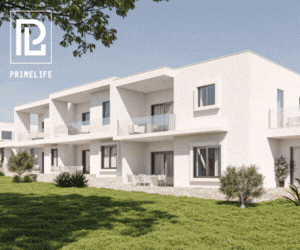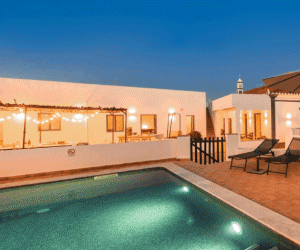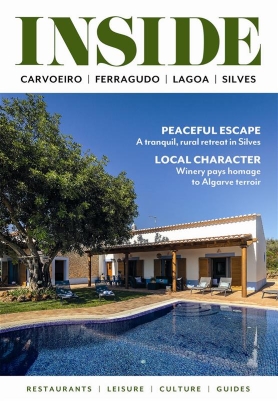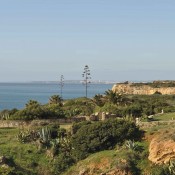
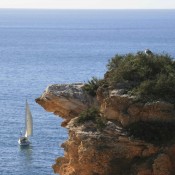
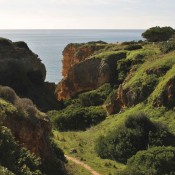
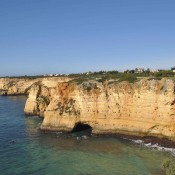
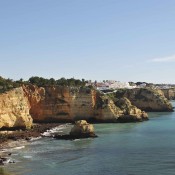
JOURNALIST ANABELA GASPAR TAKES US ON A GUIDED WALK ALONG ONE OF THE MOST SPECTACULAR STRETCHES OF COASTLINE IN THE AREA
Awalk along Lagoa’s coastline is a thrill, no matter how many times you do it. For this issue, we discovered the stretch between Praia do Paraíso and Praia do Vale da Lapa – an un-signposted section.
No matter how many times I walk above Lagoa’s cliffs, I am always left speechless by its stunning scenery. The entire coastline is shaped by an array of rugged golden cliffs, dotted with sinkholes, arches, caves, evergreen pine trees and mastic shrubs, and washed by the shimmering vast Atlantic Ocean. And yet, along the coast’s various sections nature offers ever-new perspectives, and always appears different to the viewer. When we took these photos in early spring, the cliffs were at their greenest with Bermuda buttercup blossoms here and there. Our starting point is Praia do Paraíso (paradise beach) west of the well-known beach of Carvoeiro. This small, sheltered bay, boasting fine sand and clear water, more than deserves its name. As the beach is only accessible via a long, steep staircase there will always be a little spot for your towel here, even in the height of summer. But the beach is not our destination today, despite clear skies and sunshine. In the car park we take some pictures of the bay, and down the white cobblestone stairs nestling in the slope, before passing the restaurant, and joining the trail above the cliffs. From here the white houses above the bay shine in the spring sunlight and you can spot a small cave on the beach’s eastern side. Soon Vale Currais beach extends before us, to the west. Fine sand is nowhere to be seen. Instead black rocks protrude from the water. Red cliffs protrude skyward, in a distant nod to America’s magnificent Grand Canyon. This isn’t the work of the sea’s erosive powers, surely, rather that of a talented sculptor? These natural sculptures also remind us that these rocks won’t be here forever. So be careful, especially where the path passes close to the edge and also when descending into the valley to the west of this beach.
The fence along the path is a great support in this respect, preventing walkers from slipping. The path heading up the other side of the valley proves just as steep. This stretch of coastline doesn’t require the height of fitness, we just managed it after all, but it isn’t suitable for people with walking difficulties or children. A magnificent view from the headland at Praia Salgadeira will reward you for your efforts shortly after, stretching to Lagos and Ponta da Piedade in the west and on a clear day you can even make out Sagres on the horizon. The sandy Padre Vicente beach extends west of the headland. Girdled by a group of caves, this bay is one of Lagoa’s many wild beaches that can only be reached by boat. Even though there’s a ladder at the western end, down which you can climb to the beach, the fence above the rocks blocks any access to driveable tracks. The path leads slightly below the cliff line at this point, around the cleft in the valley and then along a property fence back to the edge. Here we find one of the largest sinkholes along Lagoa’s coastline. We had been looking forward to peering down into the depths, onto the turquoise water below, but soon realise that the land is private and therefore fenced in. Slightly disappointed, we continue down into the valley of Cama da Vaca beach. At this point we lose our bearings and end up on a tennis court far from the cliffs. It is best to stay as close as you can to the edge, we learn. The path bends round the rock and then descends steeply. The Cama da Vaca beach, the strange name of which (cow bed) I will make no comment, is allegedly one of Lagoa’s best kept secrets. It is a small space – where you could only fit a cow, hence the name, perhaps – below a cliff, of which not a single centimetre remains dry at high tide. Like most beaches in this coastal section, it is only accessible by boat.
Then we head up the steep track, onto the cliffs again. Half way up my slightly out of breath walking partner remarks: “This is almost like on Kilimanjaro!” A slight exaggeration of course, but I must admit that the ascent is quite a challenge and I reach the top in a sweat. The last part however is pretty simple and flat. To the east we can see the whitewashed houses of our starting point (Carvoeiro) in the distance and not far away to the west lies our destination, Vale da Lapa beach. Shortly before Vale da Lapa I find myself standing on a rock jutting out into the sea, from which the view over the coast is incredibly beautiful. I take a deep breath of the fresh salty air,
enjoying the views in all directions. In my mind I see the scene in which Leonardo Di Caprio stands with open arms at the bow of the Titanic and I’m tempted to scream out “I’m the King of the World”. But the dizzy height I find myself at stops me. After all, I am standing on a rock just a metre and a half wide, about twenty metres above the shimmering waters below. Shortly after this quick little detour we reach our destination, one and a half hours after setting off. This beach is also very small and entirely flooded at high tide, but it is accessible by land, over a wide, driveable dirt road at first, followed by a rocky track.
The return trip is a little quicker, not least because we’ve already taken so many amazing pictures on the way there. But we still come to a halt now and then, in contemplative admiration. There are always new things to see, even the way the light falls makes the rocks seem different now.

PHOTOS ANABELA GASPAR & SUSANNE RÖHL


